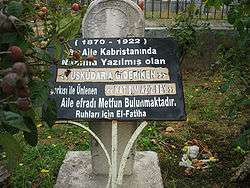Selamsız

Selamsız is a neighborhood (semt) in the municipality of Üsküdar on the Asian side of Istanbul, Turkey. It corresponds more or less to the current officially recognized neighborhoods (mahalleler) of Selami Ali and Murat Reis. These neighborhoods are bounded on the north by Sultantepe, on the north and northeast by İcadiye, on the east by Altunizade, on the south by Atik-i Valide, and on the west by Mimar Sinan.
The name selamsız means "without a selam" or "not giving a greeting; rude." The name comes from Sheikh Selami Ali,[1] who gave his name to a mosque, a dervish lodge, a public bath, and a public fountain in the neighborhood.[2] Selami Ali was called Selamsız because he was known for not looking at or greeting people when he was in public.[3]
Romani
Selamsız is one of the historic Romani (Gypsy) neighborhoods of Istanbul, along with Sulukule, Çürüklük, Küçükbakkalköy, Tophane, Çayırboyu, and Lonca, and has been since the 1700s.[4][5][6] However, 5000 Romanis are reported to have been evicted from the area in 1996.[7] According to a Council of Europe report, in 2011 the Romani population of the neighborhood was about 1400 (310 households).[8]
Sights
Mosques and dervish lodges
Mosques in the area include Selami Ali Mosque (1965),[9] Kara Alaattin Mosque (also known as Kara Kadı (Black Judge) Mosque and Çingene Fırın (Gypsy Oven) Mosque; present building constructed after 1937),[10] Gonca Gül Mosque (2001),[11] Şuca Ahmet Pasha Mosque (1692),[12] Fevziye Hatun Mosque (1882),[13] Ayazma Mescit (1982),[14] and Fatma Hatun Mescit (present building constructed after 1887).[15]
Dervish lodges in the area include Feyzullah Efendi Lodge (also known as the Hindiler (Indians) Lodge)[16] and Acıbadem Lodge (sometimes called the Selâmi Ali Efendi Lodge).[17]

Cemeteries and tombs
The biggest cemetery in the neighborhood is Bülbülderesi Cemetery. There are also tombs and small cemeteries scattered throughout the neighborhood, usually near mosques and dervish lodges, for instance, the tomb of Köstendili Ali Efendi[18] and the grave of Hadice Hanım (commonly called the tomb of "Selâmsız Baba"),[19] both near the Acıbadem Lodge.
Churches
Churches in the area include the İlya Profiti (Prophet Elijah) Greek Orthodox Church (present building built 1831), the Surp Garabet (Saint John the Baptist) Armenian Church (first church on the site, 1590; present building built 1888), and the Surp Haç (Holy Cross) Armenian Church (built 1676, rebuilt 1880).[20][21]
Schools
High schools is the area include Cumhuriyet (Republic) High School, Üsküdar American Academy, Ahmet Keleşoğlu Anatolian High School, Bağlarbaşı Private High School, Istanbul Science High School, and Surp Haç (Holy Cross) Armenian Private High School.
Elementary and middle schools include Selami Ali Primary School, Bağlarbaşı Primary School, Hilmi Çelikoğlu Primary School, Kalfayan Armenian Private Primary School, Semerciyan Cemran Armenian Private Primary School, Üsküdar Private Primary School, and the Bağlarbaşı campus of Sev Private Primary School.
Adult education centers include the Üsküdar Public Education Center.
References
- İstanbul Büyükşehir Belediyesi. İstanbul Şehir Rehberi. URL: http://sehirrehberi.ibb.gov.tr/ Retrieved 21 November 2009.
- Üsküdar Müftülüğü. Üsküdar Müftülüğüne Bağlı Camiler Listesi (List of mosques connected to the Office of the Üsküdar Mufti). URL: http://www.uskudarmuftulugu.gov.tr/?makaleid=77 Retrieved 30 November 2009.
Notes
- ↑ Özemre, Ahmed Yüksel. Hasretini Çektiğim Üsküdar. İstanbul: Kubbealti, 2007. ISBN 978-975-6444-54-2. Page 52, note 83.
- ↑ Özemre, page 203, note 307.
- ↑ Mustafa Tatcı, M. Cemâl Öztürk, and Taxhidin Bytyqi. Selâmî Ali Efendi: Hayatı, Tarîkat-Nâmesi ve Vakfiyyesi. İstanbul: Kaknüs, 2006. Pages 5152, 5253.
- ↑ Oprişan, Ana. "An Overview of the Romanlar in Turkey," in Gypsies and the Problem of Identities: Contextual, Constructed and Contested, edited by Adrian Marsh and Elin Strand. Istanbul: Svenska forskningsinstitutet, 2006. Page 163.
- ↑ "Oyuncu Kollarından Sulukule Evlerine." Star (newspaper), 15 April 2007. URL: http://www.stargazete.com/mobil/pazar/oyuncu-kollarindan-sulukule-evlerine-haber-67785.mob Retrieved 21 November 2009. Archived: https://web.archive.org/web/20110720015527/http://www.stargazete.com/mobil/pazar/oyuncu-kollarindan-sulukule-evlerine-haber-67785.mob
- ↑ Ad Hoc Committee of Experts on Roma Issues (CAHROM). Meeting Report: 2nd Meeting, Istanbul, Turkey, 22-25 November 2011. Council of Europe, 3 February 2012. URL: http://hub.coe.int/c/document_library/get_file?uuid=1b0c5e86-0e72-442d-ae1b-2eb8fbe0cb6a&groupId=10227 Retrieved 30 August 2014.
- ↑ Brearley, Margaret. "The Persecution of Gypsies in Europe," in Crimes of Hate: Selected Readings, edited by Phyllis B. Gerstenfeld and Diana Ruth Grant. Sage, 2004. Page 359.
- ↑ Ad Hoc Committee of Experts on Roma Issues (CAHROM). Meeting Report: 2nd Meeting, Istanbul, Turkey, 22-25 November 2011. Council of Europe, 3 February 2012. URL: http://hub.coe.int/c/document_library/get_file?uuid=1b0c5e86-0e72-442d-ae1b-2eb8fbe0cb6a&groupId=10227 Retrieved 30 August 2014.
- ↑ Üsküdar Belediyesi (Municipality of Üsküdar). Selâmi Ali Efendi Camii (Kuruçeşme Camii). URL: http://ebelediye.uskudar-bld.gov.tr/portal/rehber_/t1.jsp?PageName=rehberAyrinti&ID=91 Retrieved 30 November 2009.
- ↑ Üsküdar Belediyesi. Çingene Fırını Camii (Karakadı Camii). URL: http://www.uskudar-bld.gov.tr/portal/rehber_/t1.jsp?PageName=rehberAyrinti&ID=27 Retrieved 30 November 2009.
- ↑ Üsküdar Müftülüğü (Office of the Üsküdar Mufti). Goncagül Camii. URL: http://www.uskudarmuftulugu.gov.tr/uploads/files/camiler.2/goncagul.cami.doc Retrieved 30 November 2009.
- ↑ Üsküdar Belediyesi. Şüca' Bağı Camii. URL: http://www.uskudar-bld.gov.tr/portal/rehber_/t1.jsp?PageName=rehberAyrinti&ID=103 Retrieved 30 November 2009.
- ↑ Üsküdar Müftülüğü. Fevziye Hatun Camii. URL: http://www.uskudarmuftulugu.gov.tr/uploads/files/camiler.2/fevziye.hatun.camii.doc Retrieved 30 November 2009.
- ↑ Üsküdar Müftülüğü. Ayazma Mescidi. URL: http://www.uskudarmuftulugu.gov.tr/uploads/files/ayazma.mscidi.doc Retrieved 30 November 2009.
- ↑ Üsküdar Belediyesi. Fatma Hatun Mescidi. URL: http://www.uskudar-bld.gov.tr/portal/rehber_/t1.jsp?PageName=rehberAyrinti&ID=40 Retrieved 30 November 2009.
- ↑ Üsküdar Belediyesi. Hindîler Tekkesi (Feyzullah Efendi Tekkesi). URL: http://ebelediye.uskudar-bld.gov.tr/portal/rehber_/t1.jsp?PageName=rehberAyrinti&ID=133 Retrieved 30 November 2009.
- ↑ Üsküdar Belediyesi. Acıbadem Tekkesi. URL: http://ebelediye.uskudar-bld.gov.tr/portal/rehber_/t1.jsp?PageName=rehberAyrinti&ID=115 Retrieved 30 November 2009.
- ↑ Üsküdar Belediyesi. Köstendilî Ali Alâaddin Efendi Türbesi. URL: http://www.uskudar-bld.gov.tr/portal/rehber_/t1.jsp?PageName=rehberAyrinti&ID=203 Retrieved 30 November 2009.
- ↑ Üsküdar Belediyesi. Acıbadem Tekkesi.
- ↑ Üsküdar Belediyesi. Kiliseler (Churches). URL: http://www.uskudar.bel.tr/portal/rehber_/rehbern.jsp?PageName=rehbern&ID=10404&ADI=Kiliseler Retrieved 22 November 2009.
- ↑ Tuğlacı, Pars. İstanbul Ermeni Kiliseleri / Armenian Churches of Istanbul / Istʻanpuli Hayotsʻ ekeghetsʻinerě. Istanbul: Pars, 1991. ISBN 975-7423-00-9. Pages 121-129, 169-171, 194.
Coordinates: 41°01′24.55″N 29°01′45.37″E / 41.0234861°N 29.0292694°E